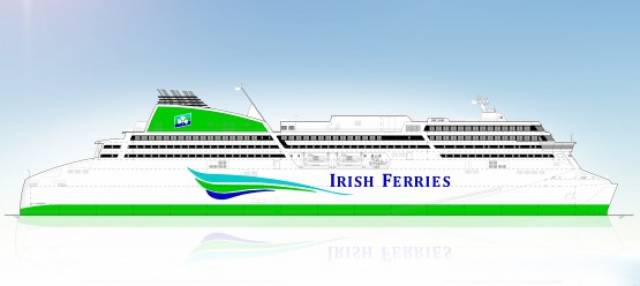#FerryNews - Progress on Irish Continental Group's €150m cruiseferry W.B. Yeats has considerably moved on since the launch of the completed hull at a German yard almost a month ago, writes Jehan Ashmore.
Construction of the newbuild's hull (photos) was kept separate to where the accommodation superstructure was built. This took place place in various facilities in neighbouring Poland. The superstructure housing facilities for 1,885 passengers and cabins totaling 435 was constructed using three giant blocks.
According to Poland @ Sea, each of the block sections;fore, amidships and aft were towed on barge-pontoons (see photos) from Poland to Flensburger Schiffbau-Gesellschaft (FSG) in Flensburg. The technical and logistical exercise involved precise engineering skills when massive heavy-lift crane barges raised and lowered the component blocks onto the hull below.
Afloat has also been monitoring the time-schedule of this operation, as the final aft block section complete with funnel was placed into position last week at the fit-out berth at FSG.
In all the combined weight of the newly formed superstructure totals 5,500 tonnes. As for the length of the hull at 195m, this is longer to the capital's iconic ‘Spire’ if laid on its side which measures at just 120m.
As previously reported, in the course of the next few months, remaining construction work on the hull (where most of the 3kms of vehicle deck space is) will be completed. In addition the fitting-out of the 54,985 gross tonnage ferry entails technical, operational, décor, furnishings and passenger amenities to be finished. This will make the ferry the most luxurious on the Irish Sea where some cabins will feature balconies which will be put to greater use on the longer French service.
Before scheduled services can commence, W.B. Yeats will undergo sea trials, crew training and docking procedures at French, UK and Irish ports into which it will operate. The maiden commercial voyage is scheduled to take place on the direct continental Dublin-Cherbourg route in mid-July and where the cruiseferry will serve the busy summer months.
In the Autumn, W.B. Yeats will transfer to the core Irish Sea route of Dublin-Holyhead. This leaves services maintained on the year-round Ireland-France route to be operated by ropax Epsilon.
In the meantime, Irish Ferries Rosslare-Cherbourg route for this season resumes service today with a night-time departure. As usual routine cruiseferry Oscar Wilde will serve the continental route. The cruiseferry fresh from annual refit has been on temporary relief duties on the Holyhead route in addition to carrying out a once-off Dublin-Cherbourg round trip last weekend.
The re-deployment of Oscar Wilde was to facilitate Epsilon while also undergoing overhaul though the ferry is take up duties again on both the Dublin routes to Wales and France. The latter service sees the ropax return on the Dublin-Cherbourg service tomorrow mid-afternoon.































































